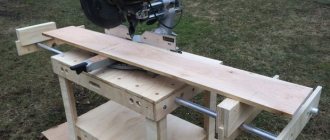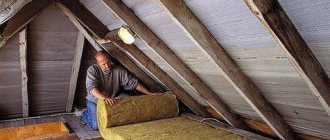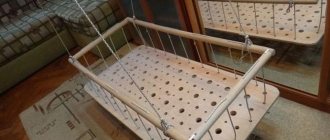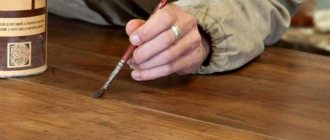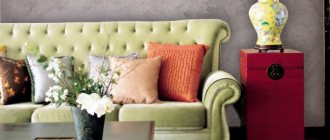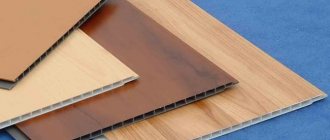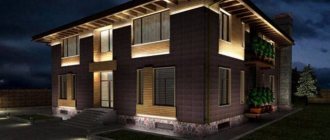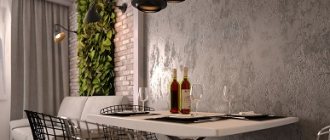4.3 / 5 ( 13 votes)
When building a house, sooner or later everyone comes to finishing the facade. And if the owners of brick houses do not need to do anything, then the owners of foam block houses have something to think about. How to insulate and how to finish - these are the two main questions. As plaster, you can choose the texture of bark beetle, fur coat, painting or mosaic plaster. That's the last one we'll talk about.
What is mosaic plaster
Mosaic plaster is a plaster that consists of stone grains of different diameters. This filling gives an interesting effect and looks good on the walls. It is very resistant to sun exposure, temperature changes and mechanical shocks.
It is mainly used on the facades of houses, because... It is believed that stone is a cold material and is not suitable for interior decoration. Moreover, it can be found quite often in public buildings. In such places, its increased strength is very much in demand.
Peculiarities
- It contains various decorative fillers; mineral granules of granite, marble, malachite, lapis lazuli, quartz sand, etc., both as individual elements and as a whole and in a mixed composition, highlighting individual aesthetic qualities.
- Heterogeneous masses act as adhesives and plasticizers; lime, gypsum, silicate, cement, acrylic, silicone, latex, etc., in different proportions with a predominance of certain components, precisely determining the scope of application, the nature of the coating and resistance to external influences.
- Particles of stones of round shape, without sharp ends, of different sizes and diameters are used, providing the layer with a pleasant texture upon tactile contact. To expand the color range, glazing pigments are added, or they convey the natural color of the stone used without tinting.
- Visually it looks unusual and interesting, with a mosaic texture of small multi-colored pebbles, with a glassy smooth and evenly ribbed relief surface. The atmosphere is a persistent and durable texture. Found under different names; mosaic, winter, marble, colored, textured, facade, for plinth, etc.
Varieties
What is it like and how can it differ?
1. Stone plasters are produced with different binder compositions:
- Acrylic (polymer), distinctively plastic and shock-resistant, form a protective layer against water ingress. Sold in ready-made liquid form, which only needs to be mixed before use, it is easy to apply. It is polymer mixtures that are most popular in the manufacture of mosaic textures. Their disadvantage is their low throughput and form a non-breathable surface.
- Mineral mixtures (gypsum, cement, lime). Gypsum comes with some restrictions on use in aggressive microclimates. For external installation, cement and lime varieties are mainly used; for internal walls, any type is suitable, usually based on gypsum or lime. They are characterized by high permeability of wet vapors. Budget representative of solutions and they are the cheapest.
- Silicate (potassium glass), adheres well to the surface, takes any shape, but hardens quickly. Therefore, a professional approach to application is required. Natural, practical, not in the expensive price segment.
- Silicone (silicone resin) is more often used for internal installation. Usually these are universal compositions, suitable for external repairs. Waterproof, plastic, with the formation of a protective film. Distinctively expensive, which is compensated by reliable performance properties.
Mixtures can be formed with a mixed composition, mineral with the addition of polymers, silicate with the addition of silicone and other options for mixing the adhesive mixture.
2. Scope of use. The chemical composition of the base determines its durability qualities, distributing the product according to the area of use, dividing it into 2 main types:
- For outdoor work.
- For interior cladding.
There are also universal solutions suitable for any premises and facade decoration.
3. Graininess. The sizes of decorative particles are found in different diameters, offering 4 varieties:
- Stones in large fractions, reaching 1.5, 2 mm.
- Medium-sized fractions of granules, varying in diameter from 1.2 mm to 1.5 mm.
- Small fraction pebbles, 0.9 mm and up to 1.2 mm in size.
- The smallest grain diameter, mainly 0.5-0.8 mm.
Also read: All types of materials for interior wall decoration
Compositions with mixed heterogeneous fractions are possible, where grains of different diameters are added.
4. Type of stones. Also determining the differences are the types of stone used, each of which offers an external image of its direction, as they differ in effects and tone. The most famous of them:
- Marble.
- Malachite.
- Quartz.
- Granite.
- Onyx.
Depending on the presence of the predominant grain in the composition, they can be called; marble, quartz, granite, etc., there are mixed options where several different rocks are added at once.
Advantages
This building material has a lot of positive qualities, notable for its increased resistance to aggressive climates. Regardless of the type of chemical content, it is characterized by general properties, where the nature of the stone itself offers the main qualities, and the adhesive substance only strengthens and complements. This behavior is uncharacteristic of other plastering canvases, where everything looks the other way around. And this is one of the positive features of the mosaic structure. Let's consider its pros and cons.
- Resistant to ultraviolet rays, does not fade for a long time, maintaining its original appearance. The stone is not exposed to the sun and does not fade from ultraviolet rays.
- Withstands external climate influences well; frost, heat, sudden temperature changes, high humidity, precipitation, wind, etc.
- It can be washed, including using detergents and special equipment with high pressure water supply.
- Supports natural moisture exchange, breathable coating that does not accumulate moisture and dampness. For acrylic, silicone and latex varieties, this indicator, compared with other coatings, is of an average level. It is vapor permeable, but releases moisture more slowly than it absorbs.
- Versatility. It can be placed on almost any base, cement, brick, plaster, concrete, but preferably on a surface without flaws, and requires preparation of the surface before application.
- Not subject to cracking and premature destruction, due to the ductility and high elasticity of the material components, especially acrylic subtypes.
- It is difficult to damage or scratch, and easily withstands physical and mechanical stress, including strong impacts.
- High resistance to the appearance and proliferation of microorganisms, therefore, it is not afraid of fungus and mold.
- It is easy to install, as it creates smooth and flat surfaces without convex shapes. If the installation does not involve artistic elements in the form of plot drawings, minimal skills and compliance with the recommendations from the manufacturer will be sufficient.
- Excellent decorative properties. The product is available in a wide range of colors and textures, suitable for both external and internal surface finishing. Mosaic plaster of the walls forms a monolithic seamless surface with fine ribbing from a variety of pebbles.
Manufacturers mainly offer substances with polymer additives; such a component is characterized by outstanding properties of plasticity, moisture resistance and durability. And even with good vapor penetration ability, where the stones themselves take on this function. To decorate walls in apartments and private houses, it is used to partially frame the surface in combination with other building materials, and not to completely cover the interior.
Flaws
Any coating also has a number of certain pronounced disadvantages.
- Relatively high cost.
- Carrying out work requires compliance with the technological regime.
- Mandatory wall preparation.
- Difficult dismantling, in case of desire to change the interior or renew damaged coating.
Some types of plaster textures can be made independently. Do-it-yourself decorative plaster, for information, follow this link.
Advantages of mosaic plaster
There are several fairly compelling advantages to pay attention to this plaster:
- It is very resistant to annual temperature changes. Rain, snow - it doesn't matter.
- This plaster does not fade from sunlight.
- It can be applied to any surface: drywall, stone, foam concrete, concrete - it can be placed on any surface.
- This plaster is vapor permeable.
- It is very elastic. Holds up small cracks well.
- Resistant to mechanical damage.
- Easy to care for. You can easily wash it.
- Easy to apply.
Tools and materials
To properly apply mosaic plaster intended for decorating walls, you should prepare. You will need:
- trowels;
- rollers with a textured surface, stamps. With the help of which drawings are formed;
- graters, graters;
- different brushes;
- stencils (if necessary);
- stainless steel spatulas, rubber bands of various sizes.
Technology of applying mosaic decorative
Work on applying mosaic decorative plaster can be carried out at an average daily temperature of at least 8 degrees.
It is applied using a trowel or spatulas to the thickness of the grain.
If you need to match 2 colors, you will have to use masking tape. To do this, we paste over the desired area. We apply decorative paint. 20 minutes after application, remove the tape. A day later we apply decorative paint of a different color in the same way.
After the plaster is applied, you need to allow two days to dry. Only after this can the work be considered completed.
Video master class:
Popular manufacturers
Advantages of mosaic plaster
Manufacturers of plasters create their mixtures according to GOST rules, so when purchasing building materials, always check the quality certificates. Only in this case can you create high-quality decor that will last for many years.
Let's look at popular manufacturers:
- Polymer plaster ceresit ct 77 mosaic look - the plaster solution is suitable for indoor and outdoor work. Manufactured in 12 colors with grain ranging from 0.8-2.0mm. The average consumption is 3-4.5 kg/m2. The solution can be stored for 6 months from the date of production in a dry place. Mosaic plaster Ceresit st 77 is presented on the construction market in the form of a ready-made mortar. The price for ceresit ct ranges from 3700 to 4500 rubles
- Mixan (mixan) - they are distinguished by their versatility, making it possible to make a protective coating for walls. Used to protect the area from mechanical damage and moisture, suitable for bathrooms. The first coat will take about 4-6 hours to dry.
- Bayramix is fireproof, dries within 24-48 hours. Due to its stated durability, it is used for halls, restaurants and shopping centers. It has good consumption, which is approximately 3 kg per 1 m2
- Bolars is an example of a sought-after material that has proven itself well in the construction market. It is necessary to dilute the mixture correctly, according to the manufacturer's instructions. For applied plaster there is no need for leveling and grouting, the solution does not spread
Mosaic plaster in the interior
- Wallmix Ш115 is a homogeneous mixture with fractions from 0.4 to 0.8 mm. During the process of applying to the walls, there is approximately 10-15 minutes to correct unevenness or errors, then the solution begins to set. It dries in moderate humidity throughout the day, after which the interior will delight you for a long time. Can be stored for a year from the date of production. Varnish is used for finishing
Important! Covering walls with mosaic plaster in photos and videos gives beginners the opportunity to get acquainted with all the features of the work.
Let's find out how much this solution will cost for outdoor use:
| Mosaic plaster for plinth with price, mosaic plaster for foundation with price | Prices |
| Baumit mosaic | 4800-5100 rub. |
| Liotherm | 4100 rub. |
| Ceresit | 3700-4500 rub. |
| Bayramix | 2800-3200 rub. |
